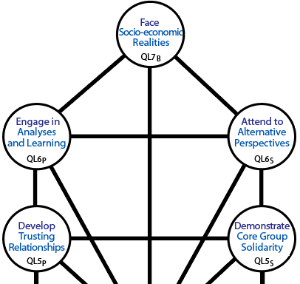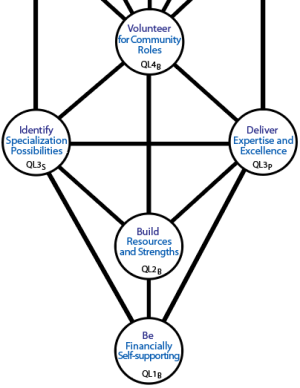Determinants of Social Standing
Dualities in the Tree Pattern
It is evident that at any Stage in strengthening financial security, pressures will appear to be coming from later Stages. This is because there is a dynamic context that operates continuously regardless of your current state.
The context for financial security is your standing in society. Whatever your stage of development, this is something that needs to be kept in mind.
To create this dynamic context, the essence of each Mode must now be considered in terms of its operation in practice. Such use of the essence immediately activates the usual dynamic duality:
- can the essence be driven by purely personal wishes and self-interest?
or
- can it be driven solely by social pressures and circumstances?
or
- are these two forces somehow fused, synthesized and spontaneously balanced?
Subscript P will be used to indicate sole personal control.
Subscript S will be used to indicate purely social-environmental control.
Subscript B indicates a balance or fusion of these controlling forces.
Each Spiral mode will now be considered in turn and converted into Levels with Centres in a THEE Tree pattern.
Become Secure
Q4-CL7: Reality-centred

In the Tree, this level becomes a single balanced Centre which we will label:
L7B: Face socio-economic realities
 Why?
Why?
There is no escaping reality: the problem is that the future is not predictable and disruption can occur at any time. Dealing with events is a personal responsibility. However, the particular realities that must be attended to and interpreted properly are generated by external forces: possibly your state of health, political shifts, new developments in your specialty, or climate change. In any case, the two influences cannot be separated.
Q4-CL6: Perspective-centred
In the Tree, this level contains two polarized but connected Centres, which we will label:
L6S: Attend to Alternative Perspectives—which is the dominant Centre
L6P: Engage in Analyses & Learning
 Why?
Why?
New ideas constantly emerge in relevant areas like it or not. These ideas often imply changes for you and your competitors, so you will need to examine them and conduct analyses. A full analysis requires taking a variety of perspectives and while this is easy for perspectives you are conversant with, others will require you to learn. So new ideas and perspectives dominate, directing and drive personal learning and analyses.
 Linkage
Linkage
Attending to alternative perspectives (L6S) prepares you for special analyses and new learning (L6P). Conversely any learning or analyses you conduct will also prepare you for the possibility of diverse perspectives.
L6S ↔ L6P is provisionally labeled Preparation

Q4-CL5: Kinship-centred
In the Tree, this level contains two polarized but connected Centres, which we will label:
L5S: Demonstrate Core Group Solidarity—which is the dominant Centre
L5P: Develop Trusting Relationships
 Why?
Why?
Forming enduring personal relationships is the foundation of feeling secure. Trust-based relations ensure you can draw on emotional and practical support when you need it most. You must contribute by using empathy, communicating honestly and responding to wishes, but trust and loyalty are a two-way street. The mutuality and solidarity that is required is a property of your small core group and this is what dominates.
 Linkage
Linkage
Demonstrations of solidarity (L5S) in your core group confirms the existence of trusting relationships (L5P) within that group. Conversely the development of trusting relationships confirms and provides confidence that your small group will show solidarity in the face of challenge.
L5S↔ L5P is provisionally labeled Confirmation

Become Established
Q4-CL4: Community-centred

In the Tree, this level becomes a single balanced Centre which we will label:
L4B: Volunteer for Community Roles
 Why?
Why?
Becoming established is about the community assigning you a proper status. Your participation in communal life will help you gain acceptance and respect. While active voluntary contributions to the community are under your control, the openings for those contributions are provided by the social milieu. The two requirements are inseparable.
Q4-CL3: Cause-centred
In the Tree, this level contains two polarized but connected Centres, which we will label:
L3P: Deliver Expertise and Excellence—which is the dominant Centre.
L3S: Identify Specialization Possibilities
 Why?
Why?
Specialization requires enthusiasm, and becoming an expert depends on passion. . There will be a range of options for specialization and this is provided by the environment and not under your control. You can identify these but you alone must choose your niche. This choices lets you focus your energies and develop a mastery that others will appreciate when they seek your help or use your services. As your status comes from your expertise, that is what dominates here.
 Linkage
Linkage
Attending to alternative perspectives (L6S) prepares you for special analyses and new learning (L6P). Conversely any learning or analyses you conduct will also prepare you for the possibility of diverse perspectives.
L3S↔ L3P is provisionally labeled Interest

Q4-CL2: Power-centred
In the Tree, this level becomes a single balanced Centre which we will label:
L2B: Build Resources & Strengths
 Why?
Why?
Each person must build strengths and resources for themselves on the basis of where they stand, what their family will provide, and what they want. As previously noted, there are many strengths that can be developed: personal, social financial and legal. Exactly what strengths are most important and how resources should be acquired and used will be shaped by conventions and availability. So the personal and social factors cannot be separated.
Q4-CL1: Market-centred
In the Tree, this level becomes a single balanced Centre which we will label:
L1B: Be Financially Self-supporting
 Why?
Why?
Earning a living is a matter or each person to do in their own way. While the method depends on talents, knowledge and opportunities, it is impossible to get an income that is not socially supported, permitted and regarded as worthy. In order to be financially secure, each person must compete and do the best they can and this particularly applies at this level.
Having clarified the Centres, the next step is to confirm the Channels of bi-directional influence that have been provided in the diagrams, and to label them appropriately.
Originally posted: 1-Jun-2025

![]() Why?
Why?![]() Why?
Why?![]() Why?
Why?
![]() Why?
Why?![]() Why?
Why?![]() Why?
Why?![]() Why?
Why?

